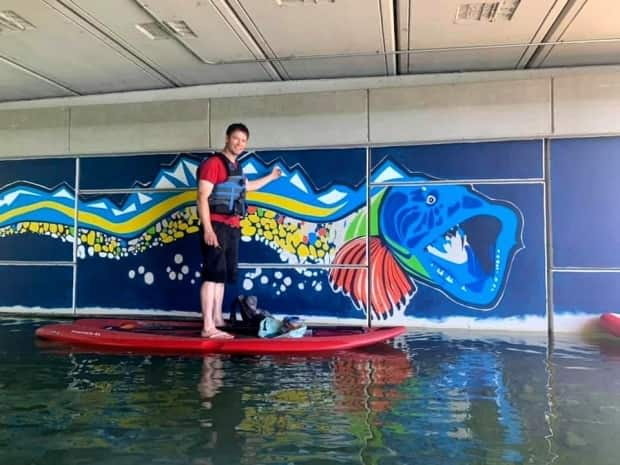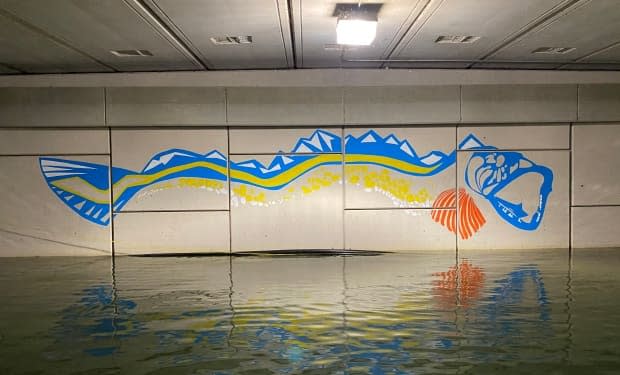Calgary mural coined 'Bownessie' tells fictional story of creature found in Bowness lagoon

A new mural under a bridge in Calgary's Bowness Park shares a funny piece of the city's history.
Calgary artist Brad Hays recently painted a nine-metre-long mural of a creature and says the inspiration stemmed from an old newspaper article.
About a year ago at a COVID-safe Neighbour Day party, a Bowness Community Association board member discovered an archived 1942 Calgary Herald article about a man catching a fish in the Bowness Lagoon, Hays says.
The article described the catch as an "Ogopogo," which is a gibberish word derived from n ̓x̌ax̌aitkʷ in the Syilx language — pronounced "n-ha-ha-it-koo" — meaning "something in the water," according to Chief Byron Louis of the Okanagan Indian Band, one of the seven communities of the Syilx Nation in B.C.
The mystical creature's name and story carry religious meaning to the Syilx Nation and is believed to inhabit Okanagan Lake.

Hays says what was found in the Bowness Lagoon was actually a 1.5-metre ling cod, not an Ogopogo, however the decade-old story still provided some inspiration.
After consulting with the city, he decide to paint a mural of the imaginary creature under the Bowness Bridge.
Painting 'Bownessie'
Hays says once he came up with the idea, there were a few hoops he had to jump through to get the drawing of the creature up on the wall.
First, he did more research into how to design the creature and ended up connecting with Randy Bottle, a Blackfoot elder, to talk about the meaning of the land and water in the area.
"He really brought light to the fact that when when people see [the mural] and they're like in their boats or on skates, he said to me, 'What are people going to take away from this?'" said Hays.
"It started to come to me that I should do more than just the design. I should sort of create a map out of this thing."
At the head of the mural, Hays says one will recognize a ling cod but that it starts to transform as it moves toward the tail — adding the Rocky Mountains, rolling hills, a soaring owl and specks of rocks often found in the Bow River.
"It sort of showcases two different concepts through the design and, yeah, that in itself tells the story of where this fish came from," he said.
Once he gathered all of his research and settled on a design, Hays started to get painting; however the body of water in the lagoon didn't make it easy.

"I wanted to do it before the water level rose [but] … we had to get permission for all of these different things that tied up some time. And by the time everything was finally approved, the water level had come up," he said.
"At the time, there was no way to really figure out how to do it without being on a boat of some sort or standing in the water."
He ended up opting for a paddle board, which luckily became the perfect solution for painting the giant fish.
"I ended up freehand drawing it and I just took my time and went out whenever I could," he said.
Despite the appropriate floating device, it still came with a few challenges.
"I had to go kind of top down into the water to get the lower parts and then stand up to do the highest section. And when I was doing the lower part, I would be crouched down and my legs would start to get numb and I'd have to get them out of that and put them in the water," he said.
But it was all worth it after seeing the community's positive response to the mural, with many stopping by to ask Hays about the mural as he painted it.
"Just the engagement that I got from people floating by and from Seasons of Bowness restaurant, it was incredible," he said. "And it's so fun, like hanging out, chatting to people about it, too, because it does tell an amazing story about the history of the park and what it was and where it is now."
With files from the Calgary Eyeopener.

